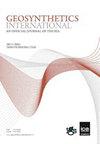土工合成材料加筋路堤渐进破坏的离心模拟
IF 3.3
2区 工程技术
Q2 ENGINEERING, GEOLOGICAL
引用次数: 0
摘要
了解软基上土工合成材料加筋路堤的破坏机理对于确保设计安全至关重要。本研究旨在利用离心试验和数值模拟研究不同层和长度土工合成钢筋加固路堤的破坏机理和稳定性。结果表明,在建基础表现出土工合成筋的渐进剪切破坏和拉伸破坏。软粘土层中的塑性剪切应变从中心线、路肩和路堤坡脚开始,并向前和向后传播,直到形成临界滑动面。在路堤中心观察到土工合成材料的拉伸破坏。相比之下,事实证明,使用两层较短的土工合成材料比使用一层全长的土工复合材料更有利于整体稳定性。通过分析地基中的应变分布,阐明了不同数量土工合成材料层加固路堤的变形模式。研究发现,土工合成层数量的增加扩展了软粘土中的活动剪切带。本文章由计算机程序翻译,如有差异,请以英文原文为准。
Centrifuge modeling of the progressive failure of geosynthetic-reinforced embankments
Understanding the failure mechanism of geosynthetic-reinforced embankments on soft foundations is crucial for ensuring safety in design. This study aimed to investigate the failure mechanism and stability of embankments reinforced with varying layers and lengths of geosynthetic reinforcements utilizing centrifuge testing and numerical modeling. The results show that a foundation under construction exhibits a progressive shear failure coupled with a tensile failure of the geosynthetic reinforcement. The plastic shear strain in the soft clay layer initiates at the centerline, shoulder and the embankment toe and propagates both forward and backward until a critical slip surface develops. The tensile failure of the geosynthetic was observed at the embankment center. Comparatively, implementing two shorter layers of geosynthetics proved more advantageous for overall stability than using a single layer with the entire length. By analyzing the strain distribution in the foundation, the deformation modes of the embankment reinforced by different numbers of geosynthetic layers were clarified. It found that increasing the number of geosynthetic layers extended the active shear zone in soft clay.
求助全文
通过发布文献求助,成功后即可免费获取论文全文。
去求助
来源期刊

Geosynthetics International
ENGINEERING, GEOLOGICAL-GEOSCIENCES, MULTIDISCIPLINARY
CiteScore
6.90
自引率
20.00%
发文量
91
审稿时长
>12 weeks
期刊介绍:
An online only, rapid publication journal, Geosynthetics International – an official journal of the International Geosynthetics Society (IGS) – publishes the best information on current geosynthetics technology in research, design innovation, new materials and construction practice.
Topics covered
The whole of geosynthetic materials (including natural fibre products) such as research, behaviour, performance analysis, testing, design, construction methods, case histories and field experience. Geosynthetics International is received by all members of the IGS as part of their membership, and is published in e-only format six times a year.
 求助内容:
求助内容: 应助结果提醒方式:
应助结果提醒方式:


